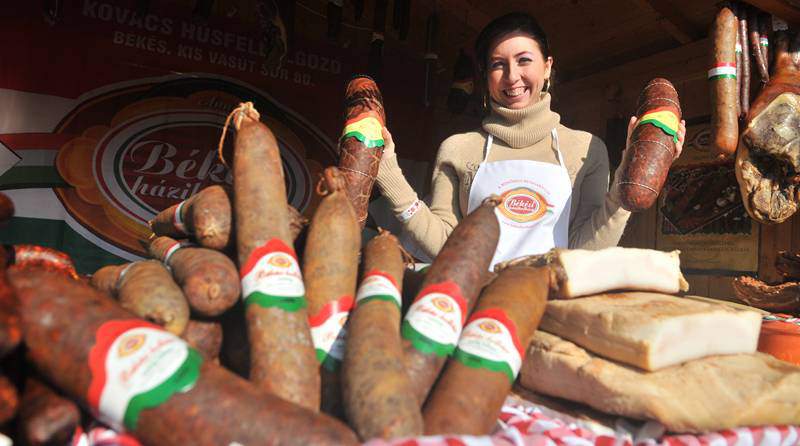The nine best Hungarian products – Photos
In general, we are very picky when we are in a supermarket. We carefully take into consideration how much sugar or allergens a product contains, or whether it is gluten-free or not. Besides these factors, there is one more that could be important: where that product was made. By buying Hungarian products we support the Hungarian economy, with an additional advantage: they are delicious. Hvg.hu collected the best nine Hungarian products you should not miss.
1. Spritz cookies
Many Hungarian residents may have forgotten about this delicious cookie, even though it was popular during the Socialist era. Luckily, there are thousands of different recipes on the Internet, but you might be surprised about how difficult it is to make. Do not worry, though. These delicious cookies can still be found in different supermarkets in the traditional chocolate and vanilla flavours. With a glass of milk, it is always perfect.

Photo: www.pinterest.com
2. Pickled cucumber
Magnesium, iron, phosphorus, calcium, potassium, vitamin C, A and B12. These are not the minerals of a brand new nutritional supplement but pickled cucumber’s. The most popular pickled goods are made with lactic fermentation which is healthy for our stomachs and intestinal flora. This is not the only advantage of leavened cucumbers, though. It is also a perfect stress reliever.

3. Acacia honey
Acacia honey is a miracle. It is good for coughs, for our liver, and strengthens the immune system and bones. An interesting fact is that acacia trees are not indigenous in Hungary but come from North-America. Sámuel Tessedik, who was a Slovakian-Hungarian chaplain, brought acacia trees to Hungary. Today, Hungarian forests consist of 20% of acacia trees which is 60% of the European tree supply. Acacia honey is the most popular and most delicious type of honey in Hungary.

4. Bacon
Bacon as a Hungarian product? Yes! Bacon is made of pork which is the most common domestic animal in Hungary. According to a Hungarian story, the word bacon comes from Bakony, which is a mountainous region next to Lake Balaton.

5. Salami
Salami is one of Hungary’s most important export-products, and many types can be found on the supermarket shelves. Hungarian gastronomy could not exist without salami. The recipe comes from Italian butcher Ármin Herz. The first Hungarian salami factory was opened in 1888, and the delicious product won awards both in Hungary and on the French World’s Fair in 1900. Whether Italians do or do not do it better, salami is truly Hungarian.

6. Sausages
This product has been part of the Hungarian gastronomy for a long time. It was found in Latin descriptions from the 14th century, in a glossary from 1407 and it officially became a Hungarian word in 1865. Sausages are also an important part of Hungarian culture, e.g. for folk-tales and Hungarian traditions. Pig slaughters are also important in Hungary, and the most anticipated result is, of course, the sausage. Because of the Hungarian paprika which gives the sausage a delicious taste, it is one of the most popular products in Europe.

7. Eggs
Eggs have been important since the birth of humanity. It is no surprise that it has a significant and efficient role in the Hungarian economy. Many farmers are proud of their eggs. Besides its excellent quality, it is also healthy. One egg contains vitamin A, B, D and E. In general, a Hungarian resident eats approximately 270 eggs per year.

8. Horseradish
When a tourist eats horseradish, the taste of it will not be soon forgotten. It is an agricultural plant in Hungary, dating back to the 15th century. Although a lot of people only buy it during Easter for the ham, horseradish can be served with different kinds of meats as well. Its taste might be scary, but it is highly recommended, as it contains vitamin C and is effective for muscle pain.

Photo: www.mindmegette.hu
9. Fondant (Szaloncukor)
This is truly a traditional Hungarian sweet and a typical Hungaricum. However, it cannot be called 100% Hungarian because, originally, this type of sweets was called fondant sugar and was made in France. But Hungarian people started to think differently. They put these sweets into silk-paper and hung them on Christmas trees. This is how szaloncukor was born. Today, a lot of companies make these sweets in different flavours, but one thing is for sure: every piece of them is Hungarian.

Photo: Wikimedia Commons
Featured image: csabaikolbaszfesztival.hu
Source: hvg.hu
please make a donation here
Hot news
What happened today in Hungary – 26 July, 2024
Drama: number of births in a 20-year low in Hungary
Yay or nay? – 6 odd Hungarian delicacies that make our skin crawl
Budapest tourism “exploded” this past weekend
Container transport in Budapest may stop: How will this affect Hungarian economy?
Minister: Hungary will protect its territory by every means possible




